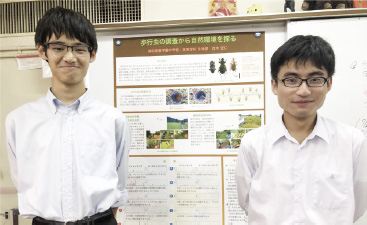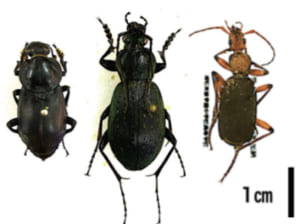- Information for Teachers
Beyond existing boundaries, connecting through personal "likes". Science Castle is a meeting place
2020.09.29
Urawa Jitsugyo Gakuen High School
Sophomore Hirohito Mogi-cun Freshman Kansheng Ogawa-cun
It happened during a poster presentation at the Science Castle 2019 Kanto Conference. A student from Tsuruoka City, Yamagata Prefecture, who came to listen to Hirohito Mogi's presentation, and I hit it off over a conversation about "insects. Science Castle is not only a place to present research, but also a place to meet new research friends.
A chance encounter attracted by the study of walking insects
Hirohito Mogi and Kansei Ogawa are a sophomore and a freshman in the biology club at Urawa Jitsugyo Gakuen High School. They both love insects. For 10 years, from 2008 to 2018, the biology club has been continuously conducting ecological surveys on walking insects (Beetles (Carabidae), subfamily Carabinae) in Katashina Village, Gunma Prefecture, and Minami Izu Town, Shizuoka Prefecture. Katashina Village is the only place in the Kanto region with exceptionally heavy snowfall and a large temperature difference between day and night in summer. Minami Izu Town, on the other hand, is located at the southernmost tip of the Izu Peninsula, and mangroves have formed at the mouth of the Aono River that flows through the town. They set traps at each of these two sites and compared the type and condition of the walking insects captured. Listening to his poster presentation was a student from Tsuruoka City, Yamagata Prefecture.
We hit it off because we share the same passion for insects.
After his poster presentation, Mogi asked his counterpart about his research. He found out that he was also studying insects. He said, "His favorite insect is the mysid beetle, which is also my favorite insect. Unlike beetle larvae, the myctophid larvae are covered in black armor and look very cool! We found ourselves talking to each other as if we were on the same side," said Mogi with a twinkle in his eye. The conversation grew more lively, and we learned that different methods are used to collect insects, and that Tsuruoka City is home to a far greater variety of insects than Urawa City. I was surprised to learn that insects I had only seen in picture books could actually be collected in real life! That's amazing!" The time flew by as they talked enthusiastically. I used to think that the only people I could talk about insects in such depth with were my club mates. I was very surprised that there were people outside the school who could relate to me," he said. He hopes to keep in touch with the students in Yamagata Prefecture and do research together with them even after they become university students.
Expanding the circle of research friends to the world
It was at this time that I learned of a joint research project in which schools in Japan and overseas collaborate on research under the theme of "soil. Since the ecology of walking insects differs greatly depending on the composition of the soil in each region, he decided to participate in the project, believing that if his fellow researchers were spread throughout Japan and overseas, they could make progress in comparative research. Currently, seven schools from Japan, Singapore, Malaysia, and the Philippines have gathered to launch the research. In this project, they will build on their experience with walking insects and collaborate with other teams to conduct research on either soil ecosystems, soil and crops, civil engineering, or soil pollution. The world of our research has expanded since we first met at Science Castle." I am very much looking forward to working with my colleagues from overseas on the same theme in our international joint research.

Walking insects have degenerate wings and cannot fly, but are agile walkers. They have strong jaws and feed on worms and snails.
Left: Insects of the family Sididae
Body length is 3 mm-30 mm, with well-developed mandibles.
Tentacles are inflated at the tip. Body shape is flattened, and many have a blackish body color. Most are carrion feeders, but they also prey on fly larvae that develop on corpses.
Center: Insects of the family Ophiuroidea
There are 25,000 species distributed throughout the world, but individual variation has been observed and specialized knowledge is required for classification. The life span of adults is long, lasting several years. They feed on small animals and fresh carrion, but tend to be omnivores.
Right: Insects of the family Ascomycota
The body length is around 15 mm, and the head and thorax are elongated and orange in color. The gastral tergites are 7- or 8-segmented, unlike the 6-segmented gastral tergites of gomphids.
*Reprinted from "Education Support vol. 47
